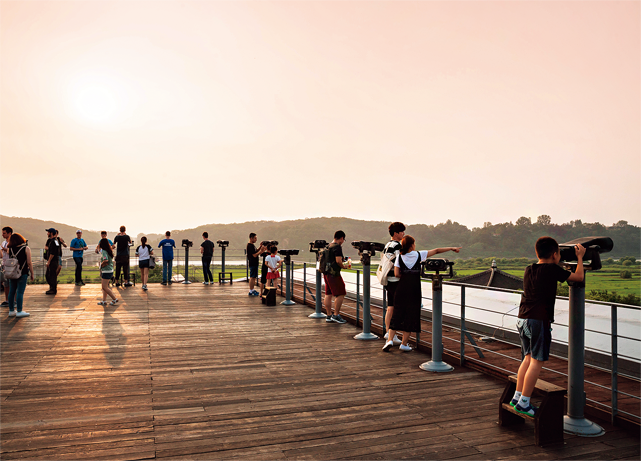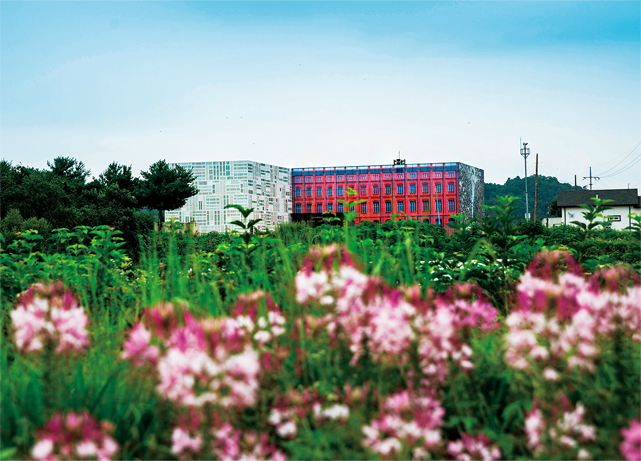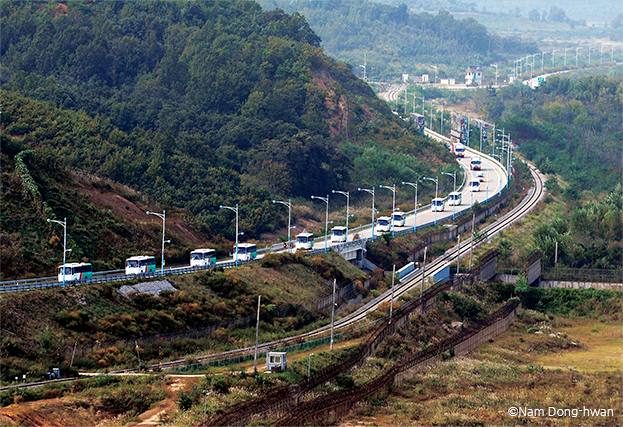The Imjin River originates in the rugged highlands on the eastern flank of the Korean Peninsula. It flows southwestward244 kilometers down through the southern borderlands of North Korea, dipping into South Korea along theDemilitarized Zone, until it meets the Han River and runs out into the Yellow Sea. The Imjin ferry landing in Paju,Gyeonggi Province was a strategic transit point for inland marine transportation before the division of the country.
“Flying Rubber Shoes of Peace,” an art installationon the DMZ Eco-Museum Trail along the Imjin Riverin Paju, uses the concertina-wire-topped fencealong the civilian control line of the DemilitarizedZone as exhibition space. People’s longing to setfoot on North Korean land is expressed as pottedseedlings set into hundreds of pairs of rubber shoeshanging on the wire fence facing north. djointly by Seong Yeon-gwi and Yang Si-hoon, it waschosen as an outstanding work in a competition foruniversity students held in 2010.
The thick scent of wildflowers is carried on the wind. I’m walkingalong the riverbank with two old friends. We went to highschool together in the early 1970s, the three of us, with thesame outlook on life. That is, we all wrote poetry. When I think aboutit, even now, it’s incredible that all three of us decided, at the age ofseventeen or eighteen, to write poetry for a living.
‘That's not poetry!’
When we were in high school, we would meet twice a week todiscuss poetry. One day we would read and discuss the latest publishedworks of established poets. And on another day we readand talked over our own poems. It was strange, but at the time wethought our own works were much more beautiful than the poemswe saw in literary journals. Our discussions were also much moreheated when we talked about our own poems. When we analyzedeach other’s works there was an exclamation that came to our lipsalmost as a force of habit: “That’s not poetry!” No matter how beautifulor profound the poems one wrote, this was the usual response.
One day, one of my friends read to us his latest work. He hadworked on that poem with greater passion than usual. But I toldhim: That’s not poetry. It’s hopeless. It reeks of the ready-made. Tellme what makes it a poem. My friend began to rummage around inhis school bag. He eventually drew out a huge army knife. The nightbefore our debate, having poured his whole soul into his writing,he had purchased the knife at the old market. To his mind he hadmade the perfect preparations. And he vowed to himself: Whoeverhears this poem and tells me it’s not poetry is no longer a friend ofmine.
We jumped up and fled from the classroom. Brandishing hisknife, my friend followed us. At the sight of a couple of studentsbeing chased by another student threatening them with a knife,passersby notified police and we were caught and hauled to thepolice station.
The military patrol path, off limits tocivilians since 1971, was transformedinto an eco-trail along the Imjin Riverand opened to the public for thefirst time in 45 years. By booking inadvance, anyone can take part in theguided tours.
Why were you chasing your friends with a knife?
They said my poem was not poetry.
The policeman was not able to take this in. So he asked again.
Why were you chasing your friends with a knife?
They said my poem was not poetry. They called it garbage.
The policeman shook his head again, and at that moment ourteacher walked in. The policeman showed him the report he hadjust written.
This boy claims he was chasing his friends with a knife becausethey said his poem was not poetry. Does that make any sense?
The teacher read the policeman’s report. His answer was short.
Yes, it does.
Under the teacher’s recognizance, we were released. And wecontinued to write poetry at school until we graduated.
During the Joseon Dynasty, the Imjinferry landing was an important stopon the road from the capital Hanyangto Uiju, far north on the border withChina. Today it is a forlorn placebeyond the civilian control line whereonly a few locals’ fishing boats comeand go once in a while.
The Painful Path by the River
I’m now walking along the riverside with those two friends.More than forty years have passed. Time has turned one friend intoa doctor, while I and the other friend both teach poetry at university.As far as a poet’s class goes, nobody can beat the doctor. Twoyears ago, a great tragedy unfolded in Korean waters. The Sewolferry sank, and 304 lives were lost. Among the dead, 250 were highschool students on a school trip. My doctor friend wrote a poemevery night, one each for all the 304 souls who had perished. Thepoems that he wrote deep into the night, after treating his patientsall day, fighting back an overwhelming sadness, will be publishedthis autumn. As for my other friend, he released an epic poem titled“The Imjin River” in 1986. It tells the story of Kim Nak-jung, a youngman in his twenties who crossed the Imjin River to North Korea inJune 1955 and returned to South Korea in June the following year.

From the viewing deck of the observatoryat Imjingak Park in Paju,7 kilometers south of the MilitaryDemarcation Line, one can see theBridge of Freedom crossing the ImjinRiver as well as the mountains andfields of North Korea.
It’s 1954, not long after the Korean War ended with an armistice.Kim draws up a unification plan titled “action plan of the independent youth community for unification.” The plan calls on youths under the age of 20 toa communitywhere they acknowledge neither South Korean nor North Korean nationality, and both sides helpthem to autonomously run the community. When confronted with this romantic but unrealistic schemefor unification, the Syngman Rhee regime brands Kim a lunatic. At the risk of death, Kim crosses theImjin River and delivers his unification plan to North Korea. But the response in the North is no different.The North Korean regime accuses him of being a spy and eventually sends him back to the South,where, over his lifetime, he is sentenced to death five times and spends 18 years in prison.
The Imjin River flows peacefully, carrying the history and tragedy that marked that young man’s life.The path that we’re walking along was opened to the public in March this year and is known as the ImjinRiver Eco Trail. It is a 9.1-kilometer trail leading from Imjingak Park, the northernmost point whereSouth Koreans are allowed to access, to the Yulgok wetlands. Flowers that I’d never seen before aregrowing by the roadside. My friend who wrote “The Imjin River” knows the names of more plants thananyone I know. He’s the best companion for walking along this path. We walk along the southern side ofthe barbed wire fence dividing the two Koreas. The breeze is soft and the river, reflecting the color of thesky, is so blue it couldn’t be any bluer.
After walking about two kilometers, we come upon a couple of art installations mounted on thebarbed wire fence. One piece is particularly eye-catching: a collection of white rubber shoes arrayed onthe fence. There must be hundreds of pairs. Inside each shoe is a wildflower in fresh bloom. They aresymbols of people who yearn to set foot on North Korean land, a place where they cannot go. Everyonewho walks along the Imjin riverside must feel the same. Our hearts ache and ache.
On June 30, 1983, the Korean Broadcasting System (KBS) began a campaign to help people find theirflesh and blood, family members from whom they had been separated by the war.
In 453 hours and 45minutes of live broadcasting over 138 days, through November 14 of the same year, 10,189 people werereunited with their lost relatives. In 2015, the broadcast archives were listed on the UNESCO Memoryof the World Register. The live broadcasts remain as vivid records of a cruel tragedy d by humanaction and the pain of love that cannot be matched by any work of literature.
‘I didn’t think I’d live to see the day’
In April 1999, the three of us actually did set foot in North Korea. Tourism to Mt. Kumgang (Geumgang)had been opened for South Koreans in November 1998. When the boat drew into Changjon Harborat dawn and let down its anchor, I couldn’t think of anything to say. The northern territory spreadbefore us was tinted brown. The mountains, the boats, the buildings — everything was the same color.Our hearts raced as we entered the customs building for immigration procedures, wondering whatwords to use to greet our northern countrymen. We tried out a few greetings but nothing seemed quiteright. To the man who took our entry papers, I finally said, “I didn’t think I’d live to see the day.” Curtly, henodded.
Our guide to Kujong Peak on Mt. Kumgang had lovely peach-tinged cheeks. I wanted to say somethingto her. But I remembered the warnings against engaging the guides in conversation. The rhododendronsare so beautiful, as if they’d been colored with rouge, I mumbled to myself behind the guide’sback. She responded: “They are beautiful, aren’t they?” That was the start of our conversation. What doyou do, comrade? I write poetry. Never before in my life had I stated my occupation with such a stirringemotion. I hope you will go on to write a lot of fine poems. That’s what she said. No greeting or farewellremarks in my memory can match this brief exchange.
“Faction,” a large-scale paintingby Han Sung-pil installedon the DMZ Eco-MuseumTrail, depicts a scene imaginedby a South Korean soldierextending his hand to an impassiveNorth Korean generalas the signboard on the NorthKorean pavilion Panmungakis changed to Tongilgak, or“Unification Pavilion.”
About seven kilometers along the hiking trail we come to the Imjin ferry landing. During the JoseonDynasty, this was an important point along the route from Hanyang (today’s Seoul) to Uiju in PyonganProvince on the Korea-China border. In the Three Kingdoms period, this was where the borders of theSilla, Goguryeo and Baekje kingdoms intersected, and therefore the site of frequent battles. During theKorean War, the soldiers of the South and the North advanced and retreated, back and forth, each sideseizing the area in turn.
At the landing, about ten wooden boats are roped together. They are fishing boats used by the localresidents. Surrounded by barbed wire, the ferry landing has a military lookout nearby and access isbarred to all outsiders. As an important stop along the old national highway No. 1 to Uiju, I had imaginedit as a large place, but it turns out to be a stretch of sand no larger than a volleyball court. Boats no longercross the river here so it’s a ferry landing no more. When we reach the Yulgok Wetlands Park, oureco-trail comes to an end.
Observatory at the Frontline
On the second day, we head for Taepung Observatory in Yeoncheon County. It stands 264 meters highby the Imjin River, 65 kilometers from Seoul and 140 kilometers from Pyongyang. One can enter theobservatory after a simple identification check. The compound includes a Protestant church, Catholiccathedral, and Buddhist dharma hall. A monument to the young soldiers of a Korean War tank brigade comes into view. While we were passionately discussing poetry during high school, other boys the sameage were driving tanks into enemy lines. “United like steel as we advance / We are Company 57, theyouth tank brigade.” This is part of the youth tank brigade’s army song, engraved on the monument. Forthese soldiers, who died heroically without a name or number, we raise a silent prayer.

A field abloom with wildflowersat the Peace WetlandPark along the ImjinRiver in Yeoncheon County.Yeongang Gallery, visiblebeyond the park, opened inMay this year after the formerSecurity Exhibition Hallwas converted into the firstart facility located inside theDMZ’s civilian control zone.
Our footsteps then come to a stop before the monument to the 36,940 American soldiers who foughtunder the UN flag and died in the war.
The dreams of 36,940 souls of making the world a better placeand living their lives to the full were buried at the foot of a mountain on the Korean Peninsula. Howshould the living lead their lives to make it all worthwhile?
We enter the observatory building. From here the North Korean guard posts can be seen. The MilitaryDemarcation Line separating South Korea from North Korea is only 800 meters away and the nearestNorth Korean guard post only 1,600 meters away, so even within the DMZ this spot is truly at thefrontline. The landscape on either side of the Imjin River, which flows through both the South and North,could not be more different. The mountains and fields on the northern side are reddish brown. There areno forests or trees in sight. We don’t realize that the bare land, so clearly visible, is actually corn fieldsuntil one of the military guards tells us so. This hurts. How do the people who plant corn at the frontlinefeel? On a clear day, they say the North Korean farm workers can be seen with the naked eye. But on theday of our visit, there is no sight of them. All we can see through the telescope are faint glimpses of theNorth Korean village Ojang-dong. In front of us is the plateau named Nori-goji. During the Korean War,4,500 bullets were fired at every area of one square meter, reducing the height of the plateau by somefive meters.
The best thing that could happen for Koreans is unification. Creating a habitat for the cranes by theImjin River, where the spectre of war still casts its shadow, and praying for the cranes to come backevery year is for us a form of totemism.

Amid a mood of reconciliationbetween the two Koreas,travel to Mt. Kumgangby sea was permitted in1998 and overland routesopened in 2003. South Koreantourists were able toenjoy a bus tour along theeast coast to the mountainacross the border until thebilateral tourism projectwas discontinued in 2008.
Coming down from the observatory, we head straight for the Pyeonghwa (Peace) Wetland Park at theedge of the Imjin River. Every year, hundreds of red-crowned cranes come to spend the winter in thismanmade wetlands park. Called hak in Korean, these white-bodied birds have a patch of red on top oftheir head. Weighing some 10 kilos and measuring about 140 centimeters in length, with a wingspanof 240 centimeters, they are considered to be auspicious birds. Koreans believe that the appearance ofthese cranes means that good fortune lies ahead. The best thing that could happen for Koreans is unification.Creating a habitat for the cranes by the Imjin River, where the spectre of war still casts its shadow,and praying for the cranes to come back every year is for us a form of totemism.
In the wetlands, the Yeoncheon county office has installed a “Slow Crane Mailbox.” Any letter writtentoday will be posted one year later. This is a nod to the patient year-long wait for the cranes thatwill return the next year.
Or perhaps it is anof earnest hopes that peace will suddenly comewithin the next year. I pick up a postcard. What should I write, I think. The guide’s last words on Mt. Kumgangsuddenly come to mind. So I write, “Keep the poetry going, till the day of unification.”